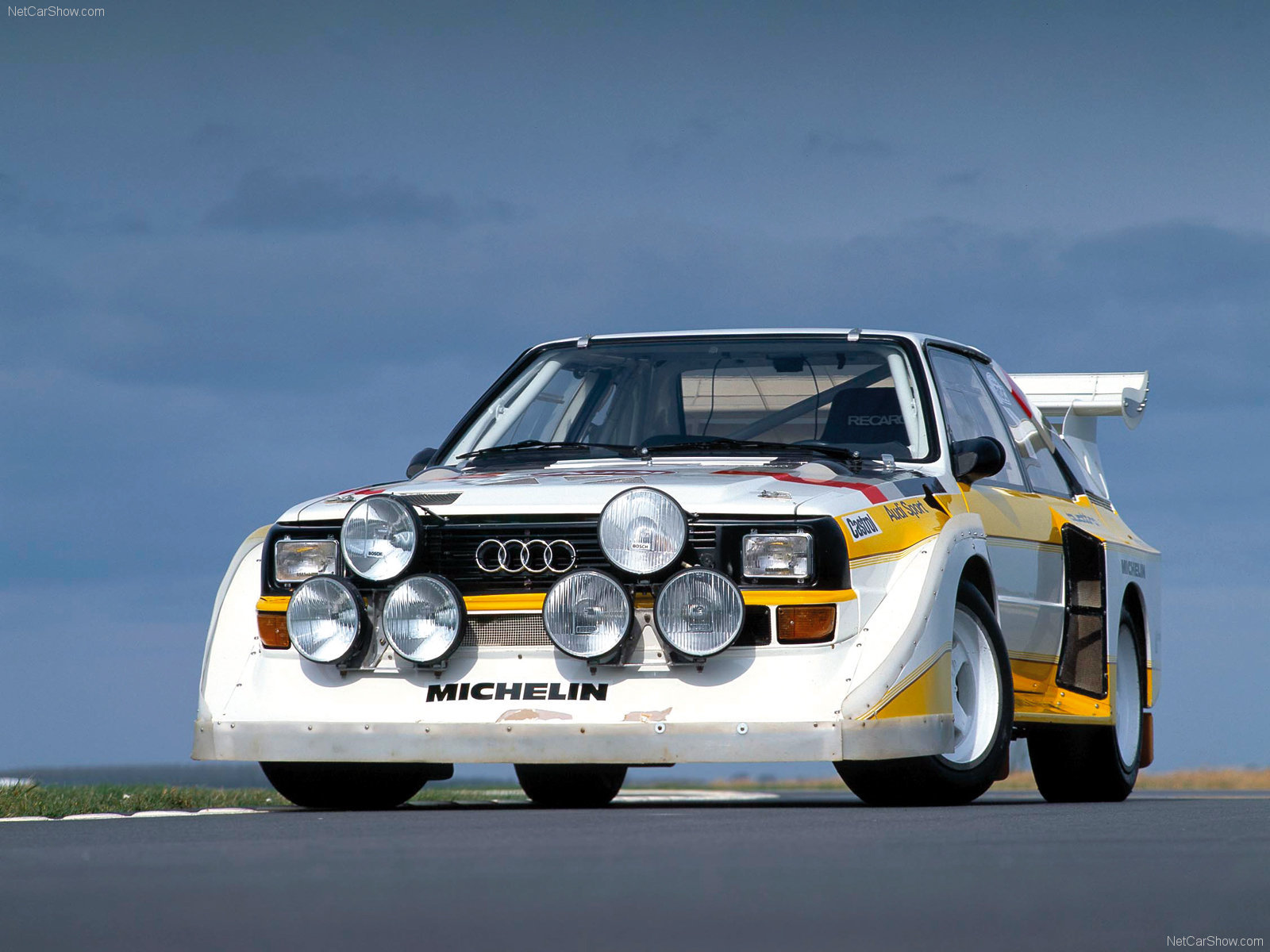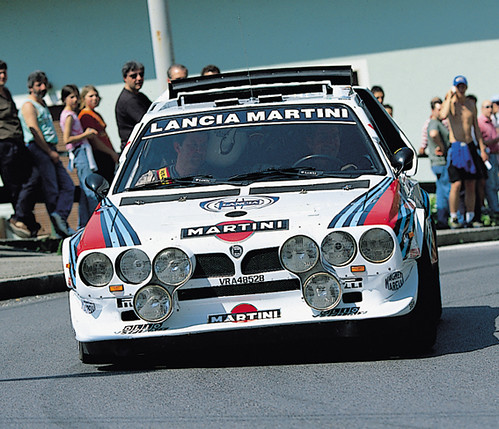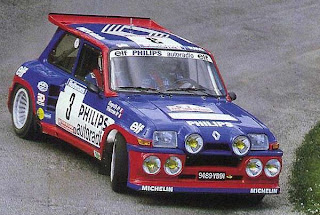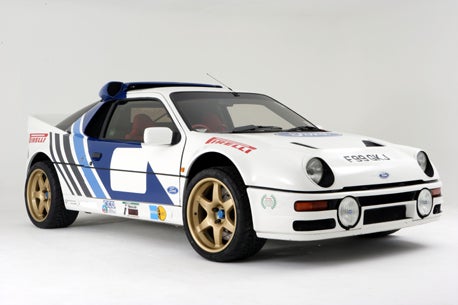Group B
Group B was a set of regulations introduced in 1982 for competition vehicles in sportscar racing and rallying regulated by the FIA. The Group B regulations fostered some of the quickest, most powerful and sophisticated rally cars ever built. However, a series of major accidents, some fatal, were blamed on their outright speed. After the death of Henri Toivonen and his co-driver Sergio Cresto in the 1986 Tour de Corse, the FIA disestablished the class, which was replaced as the top-line formula by Group A. The short-lived Group B era has acquired legendary status among rally fans.
Iconic cars:
 Audi quattro s1
Audi quattro s1:The Audi Sport Quattro S1 E2 was introduced at the end of 1985 as an update to the Audi Sport Quattro. The car featured an inline 5-cylinder engine that displaced 2,110 cc (128.8 cu in) and produced an officially quoted figure of 350 kW (480 PS; 470 bhp). However, the turbocharger utilised a recirculating air system, with the aim of keeping the turbo spinning at high rpm, when the driver closed the throttle, either to back off during cornering, or on gearshifts. This allowed the engine to resume full power immediately after the resumption of full throttle, reducing turbo lag. The actual power figure was in excess of 500 bhp (373 kW; 507 PS) at 8000 rpm.
Lancia Delta s4:
 The car's 1,759.3 cc four-cylinder engine combined supercharging and turbocharging to reduce turbo lag at low engine speeds.
Officially, the car produced 480 horsepower (350 kW), but the one that
participated in the 1986 World Rally Championship developed over 560
horsepower (417 kW). In 1985, Lancia engineers tested a S4 engine under
extreme conditions, reaching 5 bars boost, developing around 1000
horsepower. Independent figures show the S4 could accelerate from 0 to
100 km/h (62 mph) on gravel in under 2.3 seconds.[citation needed]
An engine capacity multiple of 1.4 was applied to forced induction
engines by the FIA and the choice of 1,759 cc put the S4 in the under
2,500 cc class, which allowed for a minimum weight of 890 kg (1,962 lb).
The combined super/turbocharger system (often referred to as
twincharging) was a development of the 037 engine that produced 350 hp
(261 kW) with a supercharger only.
The car's 1,759.3 cc four-cylinder engine combined supercharging and turbocharging to reduce turbo lag at low engine speeds.
Officially, the car produced 480 horsepower (350 kW), but the one that
participated in the 1986 World Rally Championship developed over 560
horsepower (417 kW). In 1985, Lancia engineers tested a S4 engine under
extreme conditions, reaching 5 bars boost, developing around 1000
horsepower. Independent figures show the S4 could accelerate from 0 to
100 km/h (62 mph) on gravel in under 2.3 seconds.[citation needed]
An engine capacity multiple of 1.4 was applied to forced induction
engines by the FIA and the choice of 1,759 cc put the S4 in the under
2,500 cc class, which allowed for a minimum weight of 890 kg (1,962 lb).
The combined super/turbocharger system (often referred to as
twincharging) was a development of the 037 engine that produced 350 hp
(261 kW) with a supercharger only.Lancia 037:
In 1981 Lancia began designing the 037 to comply with the then new FIA Group B regulations that allowed cars to race with relatively few homologation models being built. As the project was number 037, this eventually became the name by which the car was known. Abarth, now a part of the Lancia-Fiat family, did most of the design work, even incorporating styling cues from some of its famous race cars of the 1950s and 1960s such as a double bubble roof line. Prior to its first participation in the 1982 World Rally Championship season, 200 road-going models were built to comply with Group B regulations.
Unlike its predecessor, the V6-powered Lancia Stratos, the first 037s had a 2.0 liter 4-cylinder supercharged engine. Based on the long stroke twin cam which powered earlier Fiat Abarth 131 rally cars, the four valve head was carried over from the 131 Abarth but the original two carburetors were replaced by a single large Weber carburetor in early models and later with fuel injection. It features a ZF transaxle.[citation needed]
Lancia also chose a supercharger over a turbocharger to eliminate turbo lag and improve throttle response. Initially power was quoted at 265 hp (198 kW) but with the introduction of the Evolution 1 model power jumped to 300 with the help of water injection. The final Evolution 2 model produced 325 hp (242 kW) thanks to a displacement increase to 2,111 cc.
Peugeot 205 T-16
 To
homologate the 205 T16 ("Turbo 16" in France) Group B rally car,
Peugeot had to produce 200 road-going examples. A photograph showing the
200 cars was famously rumoured to be a fake.[citation needed]
Apart from the appearance, the road variants had practically nothing in
common with the regular production model and shared the transverse mid-engine, four-wheel drive
layout of the rally car, but had less than half the power; at around
200 PS (147 kW; 197 hp). The T was for Turbo; the 16 stands for 16
valves. The road going Turbo 16 205s were built by Heuliez.
Outwardly similar to a normal 205, the T16 had wider wheel arches, and
the whole rear section lifted up to give access to the engine.
Underneath, the complex drivetrain from the rally car was kept to abide
by the Group B rules. All 200 built were left-hand drive.
To
homologate the 205 T16 ("Turbo 16" in France) Group B rally car,
Peugeot had to produce 200 road-going examples. A photograph showing the
200 cars was famously rumoured to be a fake.[citation needed]
Apart from the appearance, the road variants had practically nothing in
common with the regular production model and shared the transverse mid-engine, four-wheel drive
layout of the rally car, but had less than half the power; at around
200 PS (147 kW; 197 hp). The T was for Turbo; the 16 stands for 16
valves. The road going Turbo 16 205s were built by Heuliez.
Outwardly similar to a normal 205, the T16 had wider wheel arches, and
the whole rear section lifted up to give access to the engine.
Underneath, the complex drivetrain from the rally car was kept to abide
by the Group B rules. All 200 built were left-hand drive.Renault 5 turbo:
Once the homologation models were produced, a second version named Turbo 2 was introduced using more stock Renault 5 parts replacing many of light alloy components in the original 5 Turbo version. The Turbo 2 was less expensive, but had nearly the same levels of performance, top speed of 200 km/h (120 mph) and 0-100 km/h in 6.6 seconds. In retrospect, the original 5 Turbo was called "Turbo 1".
The concept of a mid-engined small Renault returned with the 1998 announcement of the Renault Clio V6.
 All
the racing derivatives were based on the Turbo 1. The factory
pushed the engine output up to 180 PS (132 kW; 178 hp) for the Critérium
des Cévennes, 210 PS (154 kW; 207 hp) for the Tour de Corse, and by
1984 as much as 350 PS (257 kW; 345 hp) in the 5 Turbo Maxi.[citation needed]
All
the racing derivatives were based on the Turbo 1. The factory
pushed the engine output up to 180 PS (132 kW; 178 hp) for the Critérium
des Cévennes, 210 PS (154 kW; 207 hp) for the Tour de Corse, and by
1984 as much as 350 PS (257 kW; 345 hp) in the 5 Turbo Maxi.[citation needed]Driven by Jean Ragnotti in 1981, the R5 Turbo won the Monte Carlo Rally on its first outing in the World Rally Championship. The 2WD R5 turbo soon faced the competition of new Group B four-wheel drive cars that proved faster on dirt.
In 2004, Sports Car International named the R5 Turbo number nine on the list of Top Sports Cars of the 1980s.
Ford RS 200:
 The
new vehicle was a unique design, featuring a plastic/fiberglass
composite body designed by Ghia,
a mid-mounted engine and four-wheel drive. The cars were built on
behalf of Ford by another company well known for its expertise in
producing fibreglass bodies - Reliant.
To aid weight distribution, designers mounted the transmission at the
front of the car, but this required that power from the mid mounted
engine go first up to the front wheels and then be run back again to the
rear, creating a complex drive train setup. The chassis was designed by
former Formula One designer Tony Southgate,
and Ford's John Wheeler, a former F1 engineer, aided in early
development. A double wishbone suspension setup with twin dampers on all
four wheels aided handling and helped give the car what was often
regarded as being the best balanced platform of any of the RS200's
contemporary competitors. Such was the rush to complete the RS200, the
Ford parts bin was extensively raided - the front windscreen and rear
lights were identical to those of the early Sierra, for example, while
the side windows were cut-down Sierra items.Power came from a 1.8 litre,
single turbocharged Ford/Cosworth "BDT"
engine producing 250 horsepower (190 kW) in road-going trim, and
between 350 and 450 horsepower (340 kW) in racing trim; upgrade kits
were available for road-going versions to boost power output to over 300
horsepower (220 kW). Although the RS had the balance and poise
necessary to be competitive, its power-to-weight ratio was poor by
comparison, and its engine produced notorious low-RPM lag, making it
difficult to drive and ultimately less competitive. Factory driver Kalle
Grundel's third place finish at the 1986 WRC
Rally of Sweden represented the vehicle's best-ever finish in Group B
rallying competition, although the model did see limited success outside
of the ultra-competitive Group B class. However, only one event later,
at the Rally de Portugal,
a Ford RS200 was involved in one of the most dramatic accidents in WRC
history, claiming the lives of 3 spectators and injuring many others.
Another Ford RS200 was crashed by Swiss Formula One driver Marc Surer
against a tree during the 1986 Hessen-Rallye in Germany, killing his
co-driver and friend Michel Wyder instantly.
The
new vehicle was a unique design, featuring a plastic/fiberglass
composite body designed by Ghia,
a mid-mounted engine and four-wheel drive. The cars were built on
behalf of Ford by another company well known for its expertise in
producing fibreglass bodies - Reliant.
To aid weight distribution, designers mounted the transmission at the
front of the car, but this required that power from the mid mounted
engine go first up to the front wheels and then be run back again to the
rear, creating a complex drive train setup. The chassis was designed by
former Formula One designer Tony Southgate,
and Ford's John Wheeler, a former F1 engineer, aided in early
development. A double wishbone suspension setup with twin dampers on all
four wheels aided handling and helped give the car what was often
regarded as being the best balanced platform of any of the RS200's
contemporary competitors. Such was the rush to complete the RS200, the
Ford parts bin was extensively raided - the front windscreen and rear
lights were identical to those of the early Sierra, for example, while
the side windows were cut-down Sierra items.Power came from a 1.8 litre,
single turbocharged Ford/Cosworth "BDT"
engine producing 250 horsepower (190 kW) in road-going trim, and
between 350 and 450 horsepower (340 kW) in racing trim; upgrade kits
were available for road-going versions to boost power output to over 300
horsepower (220 kW). Although the RS had the balance and poise
necessary to be competitive, its power-to-weight ratio was poor by
comparison, and its engine produced notorious low-RPM lag, making it
difficult to drive and ultimately less competitive. Factory driver Kalle
Grundel's third place finish at the 1986 WRC
Rally of Sweden represented the vehicle's best-ever finish in Group B
rallying competition, although the model did see limited success outside
of the ultra-competitive Group B class. However, only one event later,
at the Rally de Portugal,
a Ford RS200 was involved in one of the most dramatic accidents in WRC
history, claiming the lives of 3 spectators and injuring many others.
Another Ford RS200 was crashed by Swiss Formula One driver Marc Surer
against a tree during the 1986 Hessen-Rallye in Germany, killing his
co-driver and friend Michel Wyder instantly.MG metro 6R4
 Created for the short lived Group B race category, the 4WD
mid engined MG 6R4 (6-cylinder, rally car, four-wheel-drive) Metro of
1984 was a world away from the best selling supermini to which it bore
only a superficial cosmetic resemblance. The competition car effectively
only shared the name of the production Metro as it featured a
mid-mounted engine with four wheel drive transmission enclosed within a
seam-welded tubular chassis. The development of this vehicle had been
entrusted to Williams Grand Prix Engineering.
Created for the short lived Group B race category, the 4WD
mid engined MG 6R4 (6-cylinder, rally car, four-wheel-drive) Metro of
1984 was a world away from the best selling supermini to which it bore
only a superficial cosmetic resemblance. The competition car effectively
only shared the name of the production Metro as it featured a
mid-mounted engine with four wheel drive transmission enclosed within a
seam-welded tubular chassis. The development of this vehicle had been
entrusted to Williams Grand Prix Engineering.The 6R4 appeared in two guises. There was a so-called Clubman model which was the road going version which developed in the region of 250 bhp (186 kW), of which around 200 were made and sold to the public for £40,000 (the homologation version). A further 20 were taken and built to International specifications which had a recorded output of over 410 bhp (306 kW; 416 PS)
Youtube video :
Δεν υπάρχουν σχόλια:
Δημοσίευση σχολίου